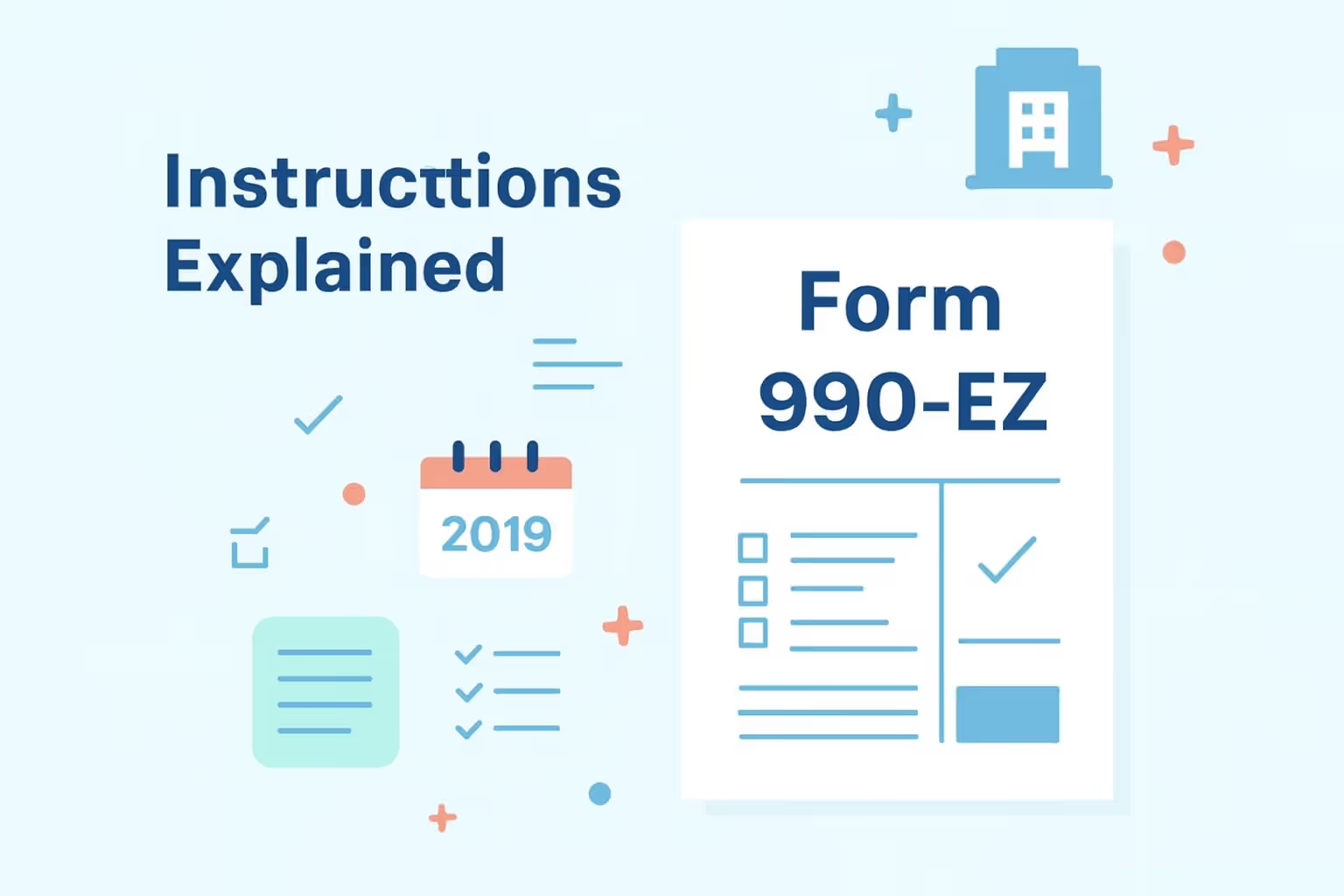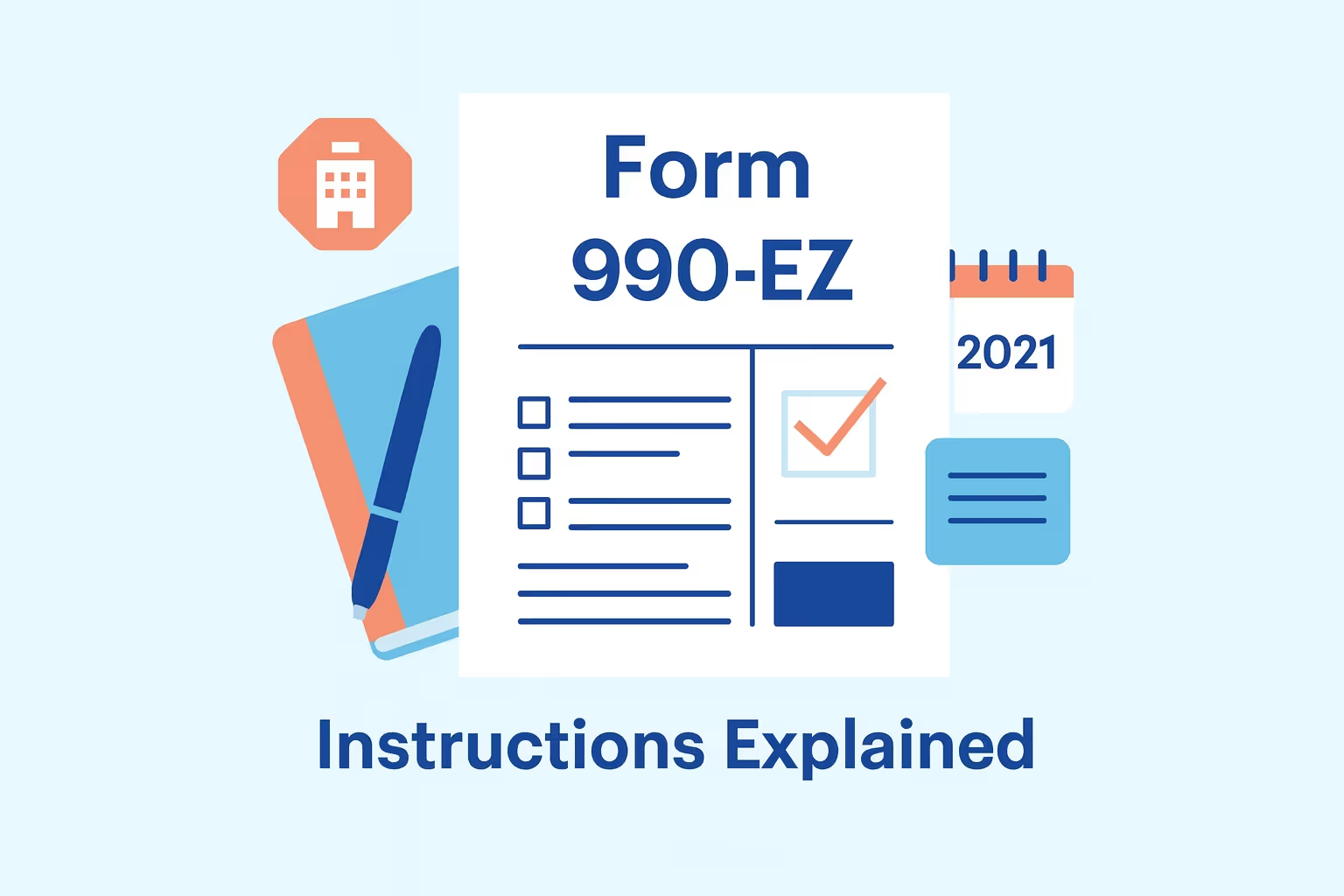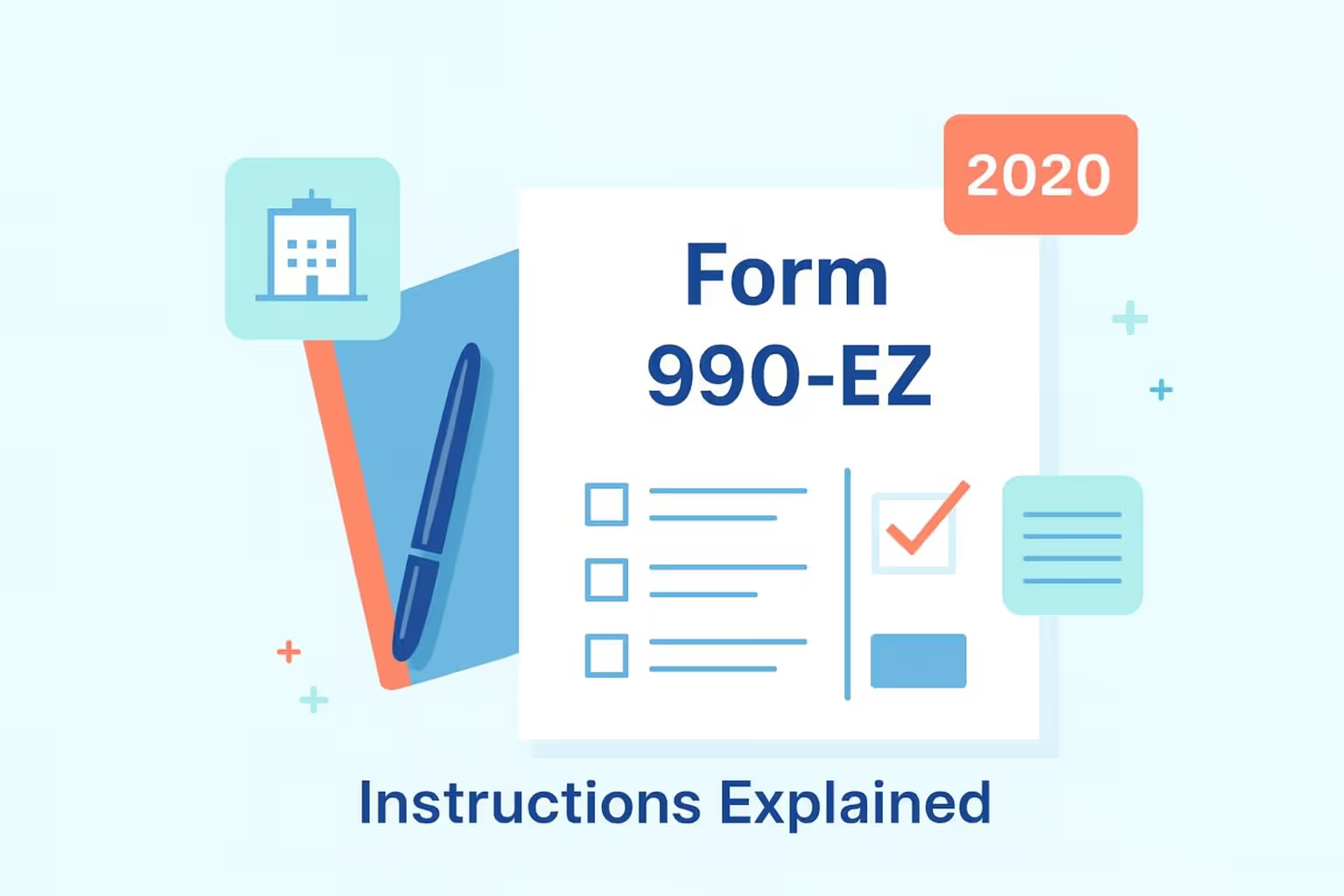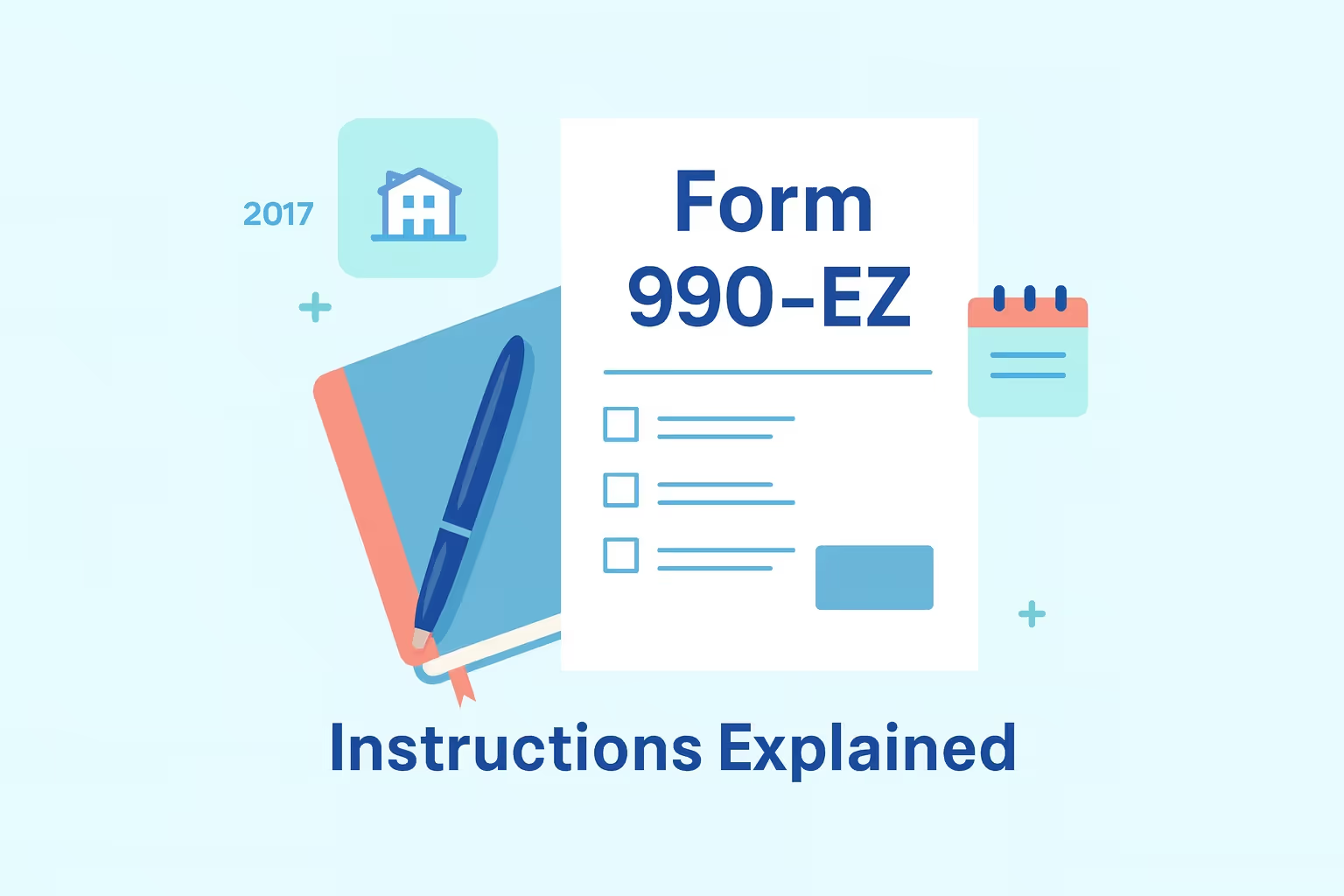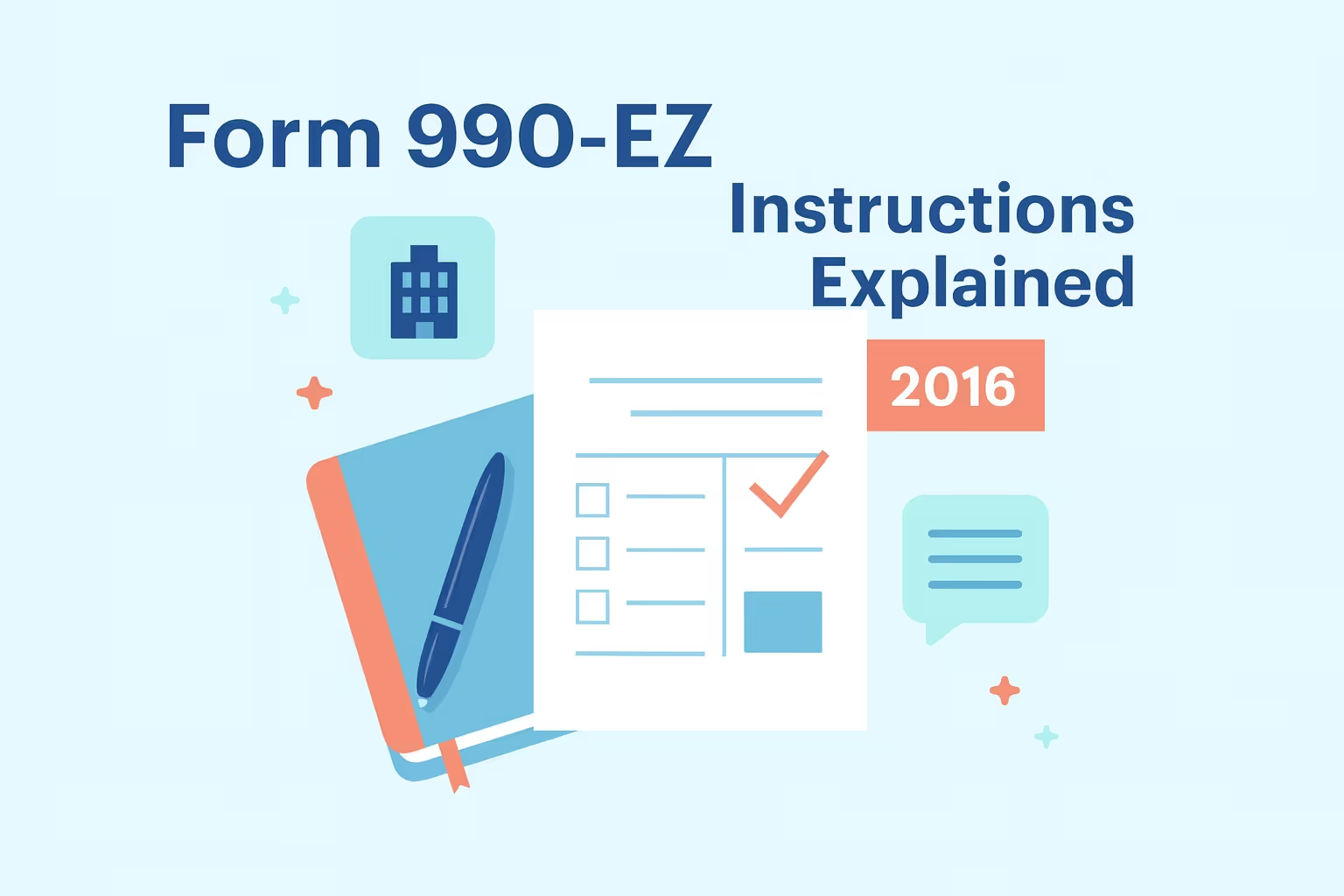Form 990-EZ 2012 Instructions: Nonprofit Filing Guide
Filing nonprofit tax returns can feel challenging for organizations focused on community programs and charitable goals. The Internal Revenue Service (IRS) requires specific tax-exempt organizations to report their annual financial activities using Form 990-EZ, a short-form return designed for smaller entities. Completing this return correctly helps maintain tax exemption, promotes transparency, and demonstrates compliance with federal tax regulations.
For the 2012 tax year, many nonprofit organizations, including charities, educational groups, and other tax-exempt entities, must verify their eligibility before filing. Organizations qualify for Form 990-EZ if their gross receipts are less than $200,000 and their total assets are below $500,000 at the end of the fiscal year. Accurate financial statements and clear records of grants, donations, and other revenue sources enable each filing organization to report income tax details accurately and confirm its financial status. Maintaining consistent documentation also reinforces accountability for the organization’s primary exempt purpose.
This guide breaks down the process into practical steps to help you determine eligibility, prepare the necessary documents, and complete each section with confidence. The IRS Form 990-EZ overview explains that the return enables nonprofits to disclose activities, governance details, and financial data required to preserve compliance with federal reporting standards.
Understanding Exempt Organizations and Filing Thresholds
Confirming eligibility for Form 990-EZ begins with reviewing the organization’s status under the federal tax code. Each organization must verify its classification as a tax-exempt entity before preparing a short-form return. Proper classification ensures compliance, accountability, and continued qualification for tax-exempt status.
An entity may qualify for tax-exempt status when it operates exclusively for charitable, educational, or religious purposes. Tax-exempt organizations include public charities, private foundations, and other nonprofit groups. Each filing organization must review its governing documents to confirm that all activities align with its charitable mission.
Organizations involved in unrelated business activities may need to report additional income tax separately. Maintaining awareness of these requirements helps prevent filing errors and delays in IRS processing. Each filer should evaluate all revenue sources before choosing the correct return.
Eligibility Requirements for Form 990-EZ
- Gross Receipts: The IRS requires organizations to confirm that gross receipts remain below $200,000 during the tax year. This figure reflects all income received from every source before deducting expenses.
- Total Assets: Total assets must be under $500,000 at the end of the fiscal year. This includes cash, property, investments, and other holdings reported on the balance sheet.
- Type of Entity: Eligible filers include charities and community-based groups. Private foundations, donor-advised funds, and controlling organizations under Section 512(b)(13) must use Form 990 instead.
- Tax Year Consistency: Each filer should maintain consistent reporting across fiscal years. Changes in accounting periods must be clearly disclosed in the return.
- Employer Identification Number: A valid Employer Identification Number (EIN) must be included on all returns. The Employer Identification Number helps the IRS track the filing organization across all tax filings and official correspondence.
Why Proper Classification Matters
Accurate filing helps maintain compliance with IRS standards and demonstrates responsible financial management. Using the correct form prevents correspondence delays and preserves recognition as a qualified tax-exempt entity. Consistency across all filings supports transparency and strengthens donor confidence.
Nonprofit organizations should regularly review their eligibility to remain aligned with reporting thresholds. Confirming requirements before submission ensures precise financial details and reduces the likelihood of errors. Clear verification enables filers to complete nonprofit tax returns that accurately and efficiently meet all IRS reporting requirements.
What Changed for Tax Year 2012
Filing organizations should monitor annual updates to maintain compliance with IRS reporting standards. The 2012 tax year introduced several revisions affecting tax-exempt organizations that use Form 990-EZ. These adjustments refined how nonprofits report key financial details, clarified tax-exempt classification standards, and ensured consistency across all filings.
Updates in Reporting Rules
The IRS refined multiple areas of the short form return to improve accuracy. Organizations must now exclude Social Security numbers from every section of Form 990-EZ. This rule protects privacy, as the form remains subject to public disclosure once it is accepted.
The updated guidance also defined electronic filing rules for short-period returns. Nonprofits filing for less than twelve months may not e-file unless submitting a final return marked “Terminated.” This measure ensures accurate data collection and prevents duplicate tax filings within the same fiscal year.
Officer and Employee Information
The IRS has streamlined the process for organizations to list their key personnel in Part IV of Form 990-EZ. Filers now report titles instead of addresses, ensuring focus on roles and responsibilities. Each organization must include all officers, directors, trustees, and the highest compensated employees. The listing should show their titles and total hours worked.
Compensation disclosures must align with the organization’s financial statements and internal records. Verified reporting of employee data reinforces transparency and demonstrates accountability in nonprofit operations. Inconsistent information may raise concerns about internal governance or oversight practices.
Schedule Clarifications
The IRS also revised several schedules attached to Form 990-EZ. Organizations completing Schedule B must carefully identify major contributors, excluding protected personal information. Clarified rules on confidential data help filers maintain compliance with federal disclosure laws.
Organizations can now report asset values directly from their records in Part II, eliminating the need to provide partnership details from Schedule K-1. This adjustment simplifies reporting for smaller entities and improves accuracy in calculating total assets and financial status.
The IRS further refined the definition of “control” under section 512(b)(13). These updates affect organizations involved with related entities or controlled groups. More precise definitions help filers determine when additional disclosures about interested persons or controlled organizations are necessary.
Understanding these revisions ensures each tax-exempt entity completes its short-form return accurately. The IRS summary of 2012 Form 990 and 990-EZ changes provides detailed clarification to help organizations meet evolving reporting standards.
Preparing to File Form 990-EZ
Organizations begin Form 990-EZ preparation with thorough planning and detailed recordkeeping. The filing organization should compile financial statements, confirm its Employer Identification Number (EIN), and review its fiscal year data before beginning the return. Proper planning supports full compliance with IRS standards for tax-exempt entities and reduces errors in nonprofit tax returns.
Reviewing Eligibility and Gathering Records
Preparation starts with confirming eligibility based on financial thresholds and organizational type. Nonprofits may file Form 990-EZ if:
- Gross receipts remain under $200,000 for the tax year.
- Total assets are below $500,000 at the end of the fiscal year.
- The organization operates for a charitable or other tax-exempt purpose and meets all IRS filing criteria for exemption.
Once eligibility is confirmed, gather records that support accurate reporting:
- Include bank statements and ledgers showing income and expenditures.
- Include grant award letters documenting external funding.
- Include board meeting minutes that authorize financial decisions.
- Include financial statements that detail revenues, expenses, and total assets.
Reviewing this data ensures each entry reflects the organization’s actual financial status. Reliable documentation demonstrates sound financial stewardship and strengthens confidence among donors and regulators.
Confirming Identification and Accounting Method
Every filing organization must include a valid Employer Identification Number (EIN) on its return. The EIN links the entity to all future tax filings and correspondence with the IRS. Using the correct number prevents processing delays and ensures each record matches existing IRS data.
Nonprofits should also verify the accounting method used for reporting. Filers may choose either:
- The cash basis records income and expenses when they are received or paid.
- The accrual basis records income and expenses when they are earned or incurred.
Consistency across all fiscal years supports accuracy in comparing financial statements. Any change in accounting method must be clearly disclosed in the return.
Ensuring Financial Accuracy and Readiness
Before completing Form 990-EZ, reconcile financial statements with supporting documents. Verify that grant amounts, program expenses, and fundraising totals align with the ledger entries. Confirm that figures reported in prior filings align with current data.
A pre-filing checklist should include each part of the form, required schedules, and the organization’s financial details. Completing this review confirms that all required information for the IRS submission is ready. Careful preparation allows tax-exempt organizations to complete accurate, transparent, and compliant nonprofit tax returns.
Step-by-Step Instructions for Completing Each Part
Completing Form 990-EZ requires accuracy, attention to detail, and clear organization. Each part of the short form return serves a specific purpose, from identifying the organization to summarizing its financial activities. Following a structured approach helps maintain compliance with IRS standards, strengthens public transparency, and demonstrates responsible stewardship of charitable resources.
Step 1: Complete the Heading
Start with the essential identifying details to establish the organization’s identity. Provide the legal name, current mailing address, and employer identification number (EIN) exactly as registered with the IRS to ensure consistency across all filings. Indicate whether the return is initial, amended, or final, and confirm the reporting period as either a calendar or fiscal year.
The organization must also select its accounting method (cash or accrual) and use it consistently throughout all future tax filings. Each entry in this section enables the IRS to track the entity’s records and filing history accurately. Accuracy in the heading supports efficient processing and prevents unnecessary correspondence from the IRS.
Step 2: Fill Out Part I – Revenue, Expenses, and Net Assets
Part I captures the organization’s financial activity for the reporting year. Enter revenue figures accurately, including total contributions, grants, and program service income, using gross amounts before any deductions. Recording gross figures ensures complete transparency in how funds are received and managed.
List all expenses such as salaries, professional fees, occupancy costs, and other operating charges to reflect the organization’s total expenditures. Each expense should correspond to entries in the financial statements and ledgers. Presenting a clear breakdown helps demonstrate how the organization allocates its resources.
Reconcile totals carefully. Subtract total expenses from total revenue to calculate the change in net assets. Confirm each figure matches the organization’s accounting records and financial statements to maintain accuracy.
Step 3: Complete Part II – Balance Sheet
The organization outlines its overall financial position in the balance sheet at the beginning and end of the tax year. Report total assets, including cash, receivables, and investments, to show available resources. Include liabilities such as accounts payable, loans, or deferred obligations, and confirm that total assets equal liabilities plus net assets for both reporting periods.
Accurate reporting reflects strong financial management and consistent recordkeeping. This process confirms that the organization’s return matches its underlying financial documents. This balance builds confidence among donors, board members, and regulatory agencies.
Step 4: Describe Program Service Accomplishments (Part III)
Use this section to describe the organization’s primary exempt purpose and measurable accomplishments. Highlight major programs, activities, and community benefits achieved during the tax year. Each description should include the related expenses to demonstrate how funds directly support charitable objectives.
For example, an educational nonprofit might report the number of students served, hours of tutoring provided, or scholarships awarded. Providing data-driven outcomes helps readers evaluate the organization’s effectiveness and community value. Strong narratives, combined with quantifiable results, enhance public trust.
Step 5: Report Governance and Compliance (Parts IV–VI)
Provide the names, titles, average hours worked, and compensation of all officers, directors, and the highest compensated employees. This information confirms the organization’s leadership structure and ensures compensation remains aligned with charitable standards. Transparency in reporting strengthens accountability and promotes ethical governance.
Answer all operational questions regarding governance, unrelated business income, and disclosure practices. Section 501(c)(3) organizations must complete Part VI to address additional compliance matters, including documentation procedures and public inspection rules. Accurate and complete responses demonstrate responsible management and reinforce the organization’s adherence to federal requirements.
Completing each section with precision ensures that the return accurately reflects the organization’s activities, financial records, and mission. Thorough reporting not only fulfills IRS obligations but also fosters trust with donors, regulators, and the communities we serve. Every carefully verified entry helps protect the organization’s tax-exempt status and reputation.
Filing Methods, Due Date, and Extensions
Selecting the correct filing method ensures that Form 990-EZ is submitted efficiently and processed without delay. Each filing organization must confirm its eligibility for electronic submission, prepare supporting schedules, and verify mailing details if submitting on paper. Proper timing and accurate reporting are essential for maintaining compliance with IRS requirements for tax-exempt organizations.
Choosing a Filing Method
Organizations can file Form 990-EZ either electronically or on paper. Electronic filing is strongly encouraged because it improves accuracy and provides faster confirmation. Filers should verify that their chosen method aligns with the organization’s technical capabilities and reporting needs.
Electronic Filing (E-File):
- Electronic filing reduces common data-entry errors through built-in validation tools.
- E-filers receive acknowledgment from the IRS upon successful submission.
- The process eliminates postage expenses and ensures faster acceptance.
- Many e-file providers enable organizations to upload data directly from their accounting systems, simplifying the preparation process.
Paper Filing:
- Paper submission is permitted when organizations are unable to e-file or must report specific changes, such as name updates.
- Each filing organization should use the correct address for its location and organizational type.
- Filers should include all required attachments, signatures, and schedules before submitting their documents.
Electronic filing remains the preferred method for eligible entities because it reduces the risk of processing delays and rejected submissions. The IRS annual filing and forms guidance outlines approved e-file options and technical requirements for nonprofits.
Understanding the Filing Deadline
- Organizations must file Form 990-EZ by the 15th day of the 5th month after the close of their tax year.
- For calendar year filers, the deadline falls on May 15 of the following year.
- Fiscal year filers must calculate the exact date based on their accounting period.
- If the deadline falls on a weekend or federal holiday, the filing date automatically moves to the next business day.
Requesting an Extension
- Organizations needing additional time may request an extension using Form 8868.
- This form grants an automatic three-month extension, with the option to apply for a second three-month period if necessary.
- Filers must submit the extension request before the original due date to avoid delayed processing or compliance notices.
- Each nonprofit should maintain a compliance calendar to track due dates and extension requests throughout the year.
Meeting every deadline reinforces organizational reliability and ensures uninterrupted recognition of tax-exempt status. Careful planning and timely submission demonstrate professionalism and commitment to federal reporting standards. Consistent compliance also builds trust with donors, grantmakers, and regulatory agencies.
Reviewing, Submitting, and Avoiding Errors
Careful review before submission protects the filing organization’s compliance record and credibility. A structured process verifies data across financial statements, gross receipts, and total assets for the organization’s tax year.
The checklist below pairs frequent errors with practical corrections. Use it to validate nonprofit tax returns before signing and mailing or e-filing.
- Employer Identification Number (EIN Mismatch)
- Risk to Filing Organization: Processing delays and IRS correspondence due to mismatched identifiers
- Prevention Checklist: Match EIN to IRS letters, prior filings, and banking documents
- Accounting Method Changes Without Explanation
- Risk to Filing Organization: Inconsistent reporting, reduced comparability, and diminished confidence in data
- Prevention Checklist: Use one accounting method consistently; document any authorized changes
- Part I Totals and Balance Sheet Not Reconciled
- Risk to Filing Organization: Suggests weak internal controls and may trigger IRS follow-up
- Prevention Checklist: Tie totals to financial statements and cross-foot every column
- Incomplete Officer Titles, Hours, or Compensation
- Risk to Filing Organization: Raises governance concerns and suggests oversight gaps
- Prevention Checklist: List each officer and highest compensated employees with full details
- Weak Program Service Descriptions
- Risk to Filing Organization: Undermines demonstration of the organization's exempt purpose
- Prevention Checklist: Include measurable outcomes, beneficiaries, and related costs
- Missing or Incorrect Required Schedules
- Risk to Filing Organization: Leads to incomplete submissions and potential rejection notices
- Prevention Checklist: Use a schedule checklist and confirm figures match the core form
- Unredacted Personal Identifiers (SSNs)
- Risk to Filing Organization: Creates privacy issues and requires correction filings
- Prevention Checklist: Redact sensitive data from all schedules and attachments
- Late Filing
- Risk to Filing Organization: Generates notices and delays compliance recognition
- Prevention Checklist: Maintain a filing calendar with internal deadlines and extension checkpoints
Before signing, compare every line to the general ledger and board-approved financial statements. Verify that all figures match original records and that totals in Part I align with the balance sheet. Confirm that program outcomes support the organization’s primary exempt purpose and that the employer identification number matches all prior tax filings.
Use a detailed checklist to confirm schedules, signatures, and page totals are complete. Review every section to validate consistency across financial statements and confirm that disclosures reflect accurate financial details. A second team member should review the return to strengthen reliability and confirm that the nonprofit tax filing meets federal reporting standards.
Finalize the process with a dated copy set, retention notes, and a calendar reminder for the following organization’s tax year. Route the final version to a second reviewer for objective confirmation and document all corrections in a clear audit trail. Completing these steps enhances precision, accountability, and public confidence in the organization’s governance.
Frequently Asked Questions
What are the filing requirements based on gross receipts?
An organization exempt from income tax may file Form 990-EZ if its gross receipts are less than $200,000 and its total assets do not exceed $500,000. These thresholds determine eligibility for the short form return. Entities exceeding these limits must use Form 990 instead. Smaller tax-exempt organizations with gross receipts of $50,000 or less can file Form 990-N (e-Postcard) to meet their annual reporting requirements.
How should an organization report its employer identification number?
Every filing organization must include its employer identification number (EIN) on all pages and attachments of Form 990-EZ. This number acts as a permanent identifier for federal reporting and should match the EIN used in previous years. Using the correct EIN enables the IRS to match filings, verify financial history, and maintain consistent records for organizations exempt from income tax.
When must key employees be listed on the return?
Key employees must be listed if their responsibilities are comparable to those of officers or directors, or if they manage a significant segment of the organization’s operations. The return must include their name, title, average weekly hours, and total compensation. Accurate reporting of key employees promotes transparency and demonstrates compliance with IRS requirements for tax-exempt organizations that are required to disclose governance and compensation details annually.
What is Schedule O used for?
Schedule O provides space for additional information and explanations required in specific parts of Form 990-EZ. It is used to clarify complex transactions, describe governance policies, or expand on responses throughout the form. Organizations use Schedule O to describe program accomplishments, list board review processes, or explain significant disposition of assets. Including these details helps the IRS and the public better understand the organization’s financial activities and operational structure.
How should organizations handle significant disposition of assets?
When a significant disposition occurs, such as the sale of a major asset or the transfer of property, the transaction must be reported clearly on the return. Organizations should explain the event in Schedule O, including its nature, value, and purpose. Proper disclosure promotes clarity and supports adherence to reporting requirements for tax-exempt organizations. Maintaining documentation of the transaction provides evidence for audits and clarifies how the asset transfer supports the organization’s exempt purpose.
Can exempt organizations file electronically through an e-file provider?
Yes, many organizations use an IRS-approved e-file provider to submit Form 990-EZ securely and efficiently. Electronic filing reduces errors and speeds acknowledgment of receipt. While most organizations are encouraged to e-file, those with complex attachments or amendments may submit paper filings when required. Choosing a reliable e-file provider ensures the organization meets submission deadlines and maintains accuracy across all form-based reporting requirements.
What if the organization filed different forms in previous years?
Organizations must choose the appropriate return each year based on their current financial status and filing thresholds. If financial changes affect eligibility, the organization may shift from Form 990-EZ to Form 990 or the e-Postcard. Consistency across previous years is essential, so review past filings before submission. Keeping detailed records supports accuracy and demonstrates that the organization is exempt from fulfilling annual reporting obligations under federal government standards.
















